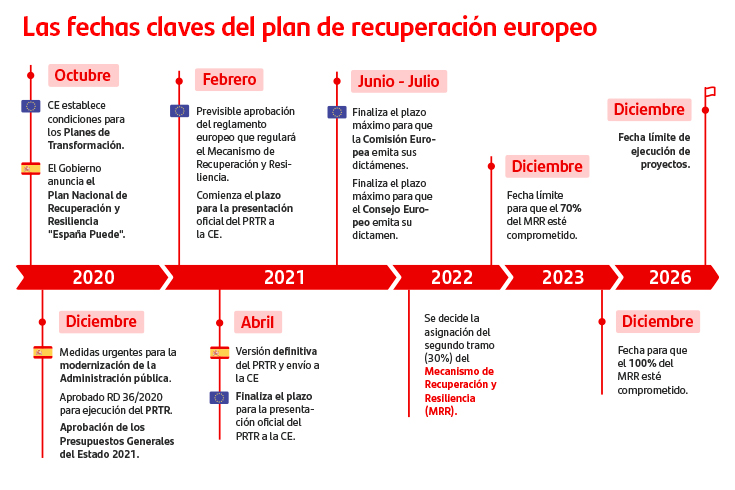Timeline of the recovery plan for Europe
ECONOMÍA Y FINANZAS I April 28, 2021
Since the beginning of the pandemic, the European Union has taken measures to repair the social and economic damage caused and to support member countries in their recovery. To this end, it has approved the highest amount of financial support in EU history for the 27 Member States, funds that will be managed both through the 2021-2027 Multiannual Financial Framework, and through the NextGenerationEU instrument. This is the chronological overview of how the recovery plan for Europe was created and how it will be implemented.
On 11 March 2020, the WHO declared COVID-19 a pandemic. All European countries, to a greater or lesser extent, began to suffer from the effects of the health, and economic, crisis caused by the SARS-CoV-2 coronavirus.
Therefore, in response to an unprecedented crisis, on 27 May 2020, the European Commission proposed the creation of a NextGenerationEU recovery fund for Europe, worth 750 billion euros (5% of the EU's GDP), as well as specific reinforcements in the EU's multiannual financial framework for the period 2021-2027.
At its meeting between 17 and 21 July 2020, the European Council (the body comprising the 27 Heads of State or Government of the Member States) approved the NextGenerationEU programme. Unlike the EU's long-term budget, which is financed by contributions from the EU-27 and some common taxes, NextGenerationEU will be financed by borrowing on the capital markets by the European Commission.
In order to access NextGenerationEU funds, and specifically its main instrument, the Recovery and Resilience Facility (RRF), which will make €672.5 billion in loans and grants available, countries must submit a national recovery plan, including projects, reforms and investments linked to the six pillars set out in the RRF, including the green transition and digital transformation. Spain will receive €149.200 billion, between direct transfers and loans.
In October 2020, the Government of Spain published the preliminary outline of the National Recovery and Resilience Plan "España Puede" (Spain Can). The plan includes reforms and investments organised around four transversal cornerstones (green transition, digital transformation, gender equality, and social and territorial cohesion) and 10 core policies consisting of 30 components.
To facilitate the agile management of the funds, the Spanish government approved and published in the Official State Gazette in December 2020 Royal Decree 36/2020 approving urgent measures for the modernisation of Public Administration and for the implementation of the Recovery, Transformation and Resilience Plan.
In parallel, the different ministries will begin to publish expressions of interest with the aim of expressing private sector needs and identifying areas of interest in which to develop projects and to achieve the best design of the instruments, lines of support or other mechanisms that will be enabled within the framework of the recovery plan.
In February 2021, the European Parliament and the Council approved the specific Regulation for the Recovery and Resilience Facility (RRF), which describes the objectives of this financial instrument and the conditions for its implementation.
On 30 April 2021, the deadline for the official submission of national recovery and resilience plans by the European Commission by countries wishing to qualify for MRR funding was completed. Spain submitted its plan that same day.
Upon receipt of the national recovery and resilience plans, the Commission will assess them within two months of receipt (until July 2021). Following the Commission, the Council will approve the plans on an individual basis within a maximum period of one month. And within two months, the EU will pay 13% of the total RRF funds upfront to kick-start recovery.
In the period from June 2021 to December 2026, and up to twice a year, Member States will request reimbursements, subject to meeting milestones and targets previously set out in recovery plans. The Commission will prepare the preliminary analysis of the request two months after the request at the latest. If the assessment is positive, Member States will receive the corresponding disbursement of European funding, after consulting the committee of experts.
In the specific case of Spain, from the second quarter of 2021 to the end of 2023, the central government, autonomous communities and municipalities are expected to publish different calls for public tenders, subsidies and grants aimed at meeting the objectives of the national recovery and resilience plan, which companies and individuals will be able to apply for.
According to its plan "España Puede", the Spanish government will earmark 70% of the non-repayable transfers (€69.528 billion for Spain) from the Recovery and Resilience Facility in 2021 and 2022.The remaining 30% will be earmarked at the end of 2023. The RRF funds can be applied until 2026, which means there will be a time gap between approving the projects and providing the funds.
The REACT-EU funds given to Spain (€12.400 billion) must be applied in 2021 and 2022. From 2022, the loans included in the RRF (up to €67.3 billion for Spain) will be mobilised for the specific initiatives listed in the plan and will be extended to all projects in 2023 as a complement to the financing of ongoing projects. Spain will have to repay its share of these repayable loans by 31 December 2058.

If you need more information you can consult the section of aid and subsidies of impulsa empresa.
Rate this item
Tu valoración ha sido guardada.
Related posts